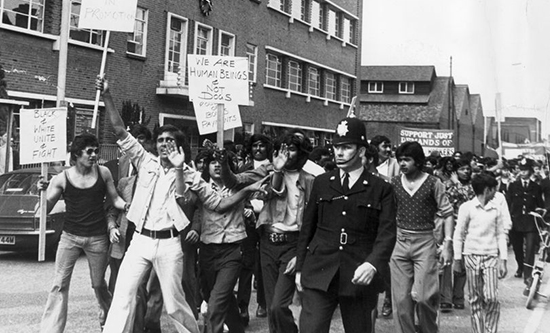
On May Day 1974 almost 1,000 workers staged walkout strikes at four factories across Leicester. At Imperial Typewriters, 39 Asian workers walked out and stayed out. 500 more workers followed them a few days later, soon reducing the factory output to 50% of normal.
The strike was an organised response to the working conditions endured by the firm’s mainly Asian workforce. Since Imperial Typewriters was bought by the multinational Litton Industries in 1968, it had recruited heavily from Leicester’s Asian population and employed a high proportion of women. White workers remaining at the firm were given special privileges by the mainly white shop stewards, reflecting the racism underpinning formal labour organisation.
Increased exploitation helped treble the firm’s turnover to £10,762,000 by 1972. Subsequent research established that the rate of pay for men was £14 below, for women £6 below, the national average. A key early demand of the strikers was to end the wage freeze endured while production targets had been hiked by 38%. Prior to the strike, workers discovered they had been short-changed on bonus payments since a new structure was introduced in 1972.
‘The strikers demanded their own shop steward to be elected by their section, who would not just negotiate on the question of production and bonuses, but also on all the important restrictions that made up their daily working lives compared to those of white workers – washing time, tea breaks, lunch breaks, toilet breaks, and so on.’1
The strike was called outside of the strictures of the Transport and General Workers’ Union (TGWU), which remained hostile to the action throughout. The overriding concern of union officials was to get the strikers back to work at the same pay while adopting ‘proper procedure’ – despite the fact that the strike happened after the TGWU factory convenor had ignored the workers’ demands.
In a shameful display of racism, the TGWU negotiator George Bromley declared that the strikes were caused by tensions between African and Indian Asians, and downplayed the suggestion of tensions between Whites and Blacks. This flew in the face of the obvious economic and social split in the working class exploited by Imperial Typewriters, which had political expression in the city’s 9,000-strong National Front voting population.
‘Between 50 to 200 workers manned the picket line continuously. The women workers played a central role. They engaged in a “fearful howling and hollering”, whenever a scab or representative of management appeared.’1 Within a few days unofficial leaders had emerged to reiterate demands for backdated pay and democratic control over production. In this way the character of the strike emerged as concerning racism within the firm and within the union.
The organisation of the strike itself was highly democratic, with mass open-air ‘grievance meetings’ held to formulate demands. These meetings formed a close bond between the mass of strikers and the leadership, and sustained the momentum of the strike by shoring up the central issues in strikers’ minds.
As the strike went on, donations came in from sympathetic labour and Asian community organisations across the country, as well as other factories with large Asian workforces. Lacking support from TGWU, the strikers went for 10 weeks without wages and defaulted on hire purchase debts. By Sunday 19 May, when a mass demonstration of 2,000 people marched through the inner city area of Highfields, six workers faced fines of £315 for obstruction and assault on the police.
As the strike entered its tenth week, Bromley ceased all collaboration with the strikers. The factory closed for two weeks’ holiday and picketing was suspended. The struggle continued, with meetings of strikers as well as a national campaign for support from the union rank and file. The hope of TGWU leadership or the Labour Party making the strike official was ultimately a vain one. At the end of July 1974, management issued notices sacking most of the strikers. Later, Litton Industries opted to close down the factory rather than make even the minimum concession to the strikers’ demands.
Conclusion
We see that in this strike, the opportunist Labour Party and TGWU acted as a fetter on advancement of the working class. While the strikers were developing new forms of collective struggle, the opportunist left did its best to draw workers back into the fold, channelling their dispute into toothless bureaucracy, and maintaining racist divisions of the working class.
Before they were sacked, the strikers’ committee had negotiated a return to work without victimisation. On 22 July they stated:
‘Throughout this dispute we knew we were fighting not only for the general interests of the working class, but for the interests of black workers in particular, since it is they who suffer from the worst injustices in employment. […] Right now the trade union movement is functioning as a white man’s union and this must be challenged. […] We do not think this can divide the working class: on the contrary it will strengthen it. We believe in the unity of the working class, but not in a sham unity.’2
Against opportunist claims that sections of the working class must lay aside their specific oppressions in the name of a broad coalition, the path to unity requires the whole working class to fight for every oppressed section – and that this what Fight Racism! Fight Imperialism! stands for.
- Ron Ramdin, The Making Of The Black Working Class In Britain, p. 274
- Race Today, 6, 9 (1974)




